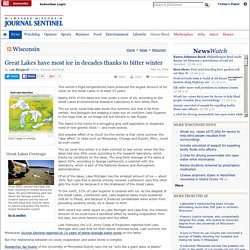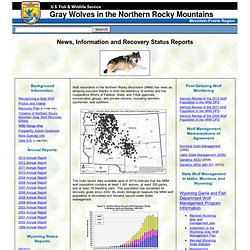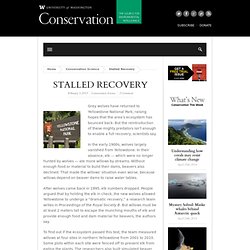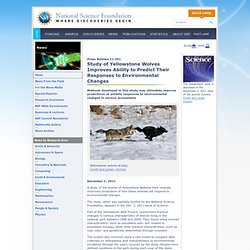

Wolf to Dog Evolution. Wolf Science by Author. The wolf of Baikal: the "Lokomotiv" early Neolithic cemetery in Siberia (Russia). (Research). The site and its location The territory around Lake Baikal features mountains, lowlands and plateaux, and includes the Watersheds of the Angara, Lena, Selenga, Barguzin, Vitim and other rivers.

Wolf Diet. Jay Mallonee. Jay Mallonee is a research biologist with a master's degree in neurobiology/animal behavior.

Through his business of Wolf and Wildlife Studies, he conducted a ten year study of the Fishtrap pack in northwest Montana: the longest behavioral study of wolves in Montana's history outside of Yellowstone National Park. Previous studies have included wolves in captivity and a variety of cetaceans such as gray whales, bottlenose dolphins, harbor porpoise, Dall's porpoise, and orcas. He also taught college level science courses for 15 years with an emphasis in environmental science and anatomy/physiology.
Behavior. Wolves - Animal and Plant Health Inspection Service (APHIS) Search Results. Wolf Management Research. Non-Lethal. Pack Structure. Wolf Communication. Canine diseases. Wolf delisting proposal. Great Lakes have most ice in decades thanks to bitter winter. This winter's frigid temperatures have produced the largest amount of ice cover on the Great Lakes in at least 25 years.

Nearly 60% of the lakes are now under a cover of ice, according to the Great Lakes Environmental Research Laboratory in Ann Arbor, Mich. The ice cover could help lake levels this summer, but that is far from certain. And biologists are keeping a close eye on northern Lake Superior in the hope that an ice bridge will link Ontario to Isle Royale.
Article - Conservation Corps. Wolf Teeth. Recent Scientific Wolf Articles Chavez_ A. S. and ... - L. David Mech. Trophic Cascades and Wolves. Wolf/Predator Interactions. Www.eenews.net/assets/2013/05/22/document_pm_03.pdf. 17-Policy%20Issues%20Related... Findings Related to the March 2010 Fatal Wolf Attack near Chignik Lake, Alaska. Western Gray Wolf: U.S. Fish and Wildlife Service. Wolf restoration in the Northern Rocky Mountains (NRM) has been an amazing success thanks to both the resiliency of wolves and the cooperative efforts of Federal, State, and Tribal agencies, conservation groups, and private citizens; including ranchers, sportsmen, and outfitters.

The most recent data available (end of 2013) indicate that the NRM wolf population contains at least 1,691 wolves, at least 320 packs, and at least 78 breeding pairs. This population has exceeded its recovery goals since 2002. By every biological measure the NRM wolf population is recovered and remains secure under State management.
Long-term, the Service expects the entire NRM population to maintain a long-term average of around 1,000 wolves. These wolves represent a 400-mile southern range extension of a vast contiguous wolf population that numbers over 12,000 wolves in western Canada and about 65,000 wolves across all of Canada and Alaska. Recent Actions: Federal Register Notice Federal Register Notice. Www.wolfandwildlifestudies.com/downloads/inhumanityofwolfmanagement.pdf. Stalled Recovery. Grey wolves have returned to Yellowstone National Park, raising hopes that the area’s ecosystem has bounced back.

But the reintroduction of these mighty predators isn’t enough to enable a full recovery, scientists say. In the early 1900s, wolves largely vanished from Yellowstone. In their absence, elk — which were no longer hunted by wolves — ate more willows by streams. Without enough food or material to build their dams, beavers also declined. That made the willows’ situation even worse, because willows depend on beaver dams to raise water tables. After wolves came back in 1995, elk numbers dropped. To find out if the ecosystem passed this test, the team measured willows at four sites in northern Yellowstone from 2001 to 2010. News - Study of Yellowstone Wolves Improves Ability to Predict Their Responses to Environmental Changes.
Press Release 11-251 Study of Yellowstone Wolves Improves Ability to Predict Their Responses to Environmental Changes Methods developed in this study may ultimately improve predictions of wildlife responses to environmental changes in various ecosystems December 1, 2011 A study of the wolves of Yellowstone National Park recently improved predictions of how these animals will respond to environmental changes.

The Wolves of North America. Abstract An early attempt to delineate new subspecies of the North American gray wolf and red wolf, based on museum specimens.

Though gray wolf classification has since changed substantially, this work is still of some historical interest. How dogs can walk on ice without freezing their paws. Scientists in Japan have solved a long-standing veterinary mystery: how dogs can stand and walk for so long on snow and ice without apparent discomfort, and without freezing their paws.

Scientists at Tokyo's Yamazaki Gakuen University wondered why dogs do not seem to feel the cold in their paws, even though the paws have less insulating fur than their trunks. The paws have pads containing a high fat content, which freezes less easily than other tissues, but they also have a high surface area-to-volume ratio, which means they should lose heat easily. In humans exposed to frigid temperatures, vasoconstriction occurs in the extremities to reduce the blood flow and resultant heat loss, and ensure the blood returning to the rest of the body does not cool too much. The research team, led by Dr. The counter-current heat exchange system prevents the body cooling and ensures the paw temperature stays within reasonable limits. Situating the Global Environment. Italian journal of Mammalogy : N 23 (2012) Wolves, people, territories. – Wolfen Warrior Spirit. Abstract Reliable estimates of population parameters and their trends are necessary for effective management and conservation actions, especially for endangered species such as wolves in most European countries.

Under the Habitat Directive 92/43/CEE, all countries are required to monitor the status of their endangered populations. The ultimate goal of population monitoring is to detect a change in both magnitude and direction for one of the population parameters. We discuss the importance of wolf populations monitoring in Europe, giving examples from the contributions of this theme issue, and we highlight the technical challenges of transboundary monitoring and of preventive measures implementation. Keywords Europe; population monitoring; preventive measures; transboundary monitoring; wolves Contents. The Cost of the Wild. Restoring an ecosystem to primitive grandeur is no simple matter in a complex world Pat Shipman It was a National Geographic day that I never thought I’d experience.

Hunting wolves in MT. Where are the data? Jay Mallonee. Are Hunters Good Wildlife Stewards When It Comes To Wolves? Not According To This Study. A new study likely to be controversial in some quarters suggests that hunters are not especially good wildlife stewards when the wildlife in question are wolves. While hunters long have been seen as conservation advocates for a wide range of species, when it comes to wolves the study by two University of Wisconsin-Madison researchers would seem to indicate that the only good wolf is a dead wolf in the hunter's mind.
“Hunters were some of the least tolerant of wolves among our respondents, and the closer you got to wolf range the less tolerant they were,” said Adrian Treves, a professor in the UW-Madison Nelson Institute for Environmental Studies. Professor Treves and a colleague, Kerry Martin, took up a research project beginning in 2001 to survey hunters and non-hunters on attitudes toward wolves. Critique of Wildlife Radio-tracking and its Use in National Parks: A Report to the U.S. National Park Service. Northern Prairie Wildlife Research Center February 6, 2002 L. David Mech and Shannon M. Barber This resource is based on the following source (Northern Prairie Publication 1164): Mech, L. This resource should be cited as: Mech, L. Wolf Dog Coalition - Scientists' Petition. || Go back to the Wolf Dog Coalition's main page || Back to Letters & Background Info || Wolf Dog Coalition - Scientists' Petition We the undersigned believe, based on current scientific fact and opinion that:
Predator Research. About Us « Wildlife Science Center. History WSC was founded as a federally funded research facility in 1976, in order to observe and document the physiology and behavior of a captive population of gray wolves. Although the Center no longer receives federal funding, its distinctive research continues. However, since achieving 501(c)(3) status in 1991 it has concentrated its assets and knowledge on educational programming.
It offers both on and offsite interactive presentations and overnight camping experiences to Minnesota youth by partnering with school and community-based organizations. Through its research and educational efforts, the WSC’s expertise is often sought by international, national, and regional institutions, regarding the care, handling, breeding, and ecological significance of wolves. 'Apparent wolf attack': Campers say wolf tore through campground. Early Monday morning, an average-sized male wolf of about 75 pounds, matching the description of the wolf in the attack, was trapped and killed in the campground. The wolf is being taken to the University of Minnesota veterinary diagnostic lab to be tested for rabies.
Also, the lab will collect samples for DNA analyses and complete a thorough medical examination to determine the health of the animal. (Courtesy Department of Natural Resources) Wildlife officials on Monday were investigating a reported wolf attack on a 16-year-old boy camping last weekend in northern Minnesota. Yellowstone National Park. Editor's note: The following story was produced by the University of Wyoming communications staff.